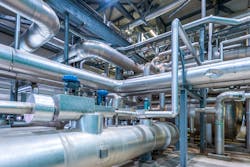Previous columns have covered operation under vacuum and measuring downward liquid flow, so we move on to gravity flow.
Most flowmeter specification sheets contain information regarding the flow range in which particular flowmeters are designed to measure accurately. Often, the maximum flow rate information is expressed as a maximum velocity and/or tabulated for different flowmeter sizes and design variations. The pressure drop exhibited by the flowmeter at various flow rates is often graphed or tabulated in another section of the specification sheet.
Excessive pressure drop across any flowmeter can limit the amount of flow that can pass through the flowmeter at operating conditions. However, pipes that flow via gravity typically operate at such low upstream pressures that most flowmeters which obstruct the flow can create a relatively large pressure drop, which can hydraulically limit the flow rate to an amount that can be significantly less than the specified maximum capacity of the flowmeter. When this occurs, the upstream piping can potentially fill with liquid, flood upstream equipment and overflow. Therefore, it is extremely important that flowmeter sizing be performed carefully.
In general, when pressure drop limits flow, the upstream pressure can be increased and/or the pressure drop across the flowmeter can be reduced. It is not common to redesign a hydraulic process to accommodate a flowmeter, so in most instances, the pressure drop across the flowmeter will be reduced. This is generally achieved by increasing the size of the flowmeter, which in turn makes the flowmeter operate lower in its flow range — often degrading flowmeter performance.
David W. Spitzer is a principal at Spitzer and Boyes, LLC, which offers engineering, focused market research, writing/editing white papers, strategic marketing consulting, distribution consulting, seminars and expert witness services for manufacturing and automation companies. Spitzer has written more than 400 technical articles and 10 books about flow measurement, instrumentation and process control. He can be reached at 845-623-1830 or via spitzerandboyes.com.


